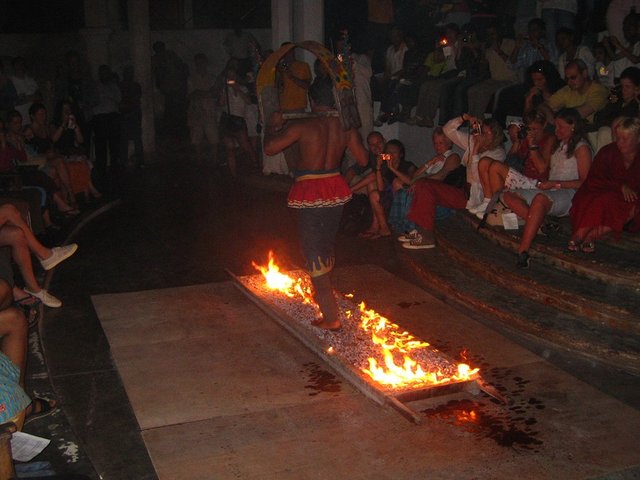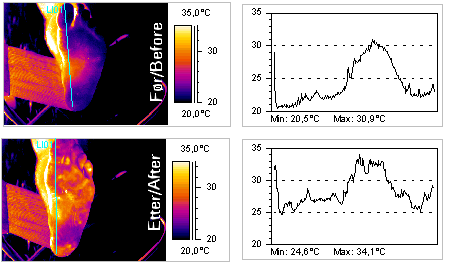Walking on Fire - Separating Phantasm and Physics (featuring @cristi as author)

Walking barefoot across hot coals is an ancient practice. Cultures all over the world have used it as rite of passage, for the strengthening of their faith, or even for healing:
- Indians, in celebrating Thimithi festival
- Eastern Christian Orthodox during certain festivals
- tribes from Pakistan in settling social justice
- Spanish, in certain regions, in celebrating Saint John's Eve
- and in many other cultures.
More recently, gurus of the new-age self-development non-sense have used it for 'turning fear into power'. According to Rob Carroll:
"Overcoming this fear is presented as a step in restructuring one's mind, almost as if this trial by fire was some sort of initiation into an esoteric and very special group of risk-takers."
Esoteric baloney; there's no magic behind firewalking. Modern physics has explained the phenomenon in great detail. And I'm about to discuss it next.
Firewalking - Myths vs. Science
Ever since the early 1930s the scientific community gave attention to the practice of firewalking. Several experiments have been conducted in 1935 and 1937 and those involved noted that:
"...neither religious faith, nor supernatural powers had anything to do with the performance of the feat, and then went on to conclude that the secret of the firewalk lies in the low thermal conductivity of the burning wood and that the time of contact between the hot coals and feet is short."
The interest in this faded away until the early 1980s when it was sparked by self-help gurus.
According to Rob Carroll, walking on hot coals without getting burned is similar to putting your hands inside a hot oven: in which you don't get burned as long as you keep your hands in the air, away from the metal parts of the oven.
You do not get burned because the air has poor thermal conductivity and a low heat capacity; and the human body has a relatively high heat capacity. The situation is similar in firewalking. As pointed by Rob Carroll:
"Thus, even if the coals are very hot (1,000 to 1,200 degrees), a person with "normal" soles won't get burned as long as he or she doesn't take too long to walk across the coals and as long as the coals used do not have a very high heat capacity. Volcanic rock and certain wood embers will work just fine."
With firewalking you also do not get burned because:
- the high specific heat capacity of water (i.e.: in your foot) and the very low specific heat capacity of embers make it that the temperature of the foot changes less compared to that of the coal.
- water has higher thermal conductivity => will quickly spread the heat from the coal.
- the rich blood flow of the foot => will disperse the heat from the coal.
- firewalkers do not stand still, but quickly move across the coals.
Let's see some more recent research on this
Back in the mid 1990s, two researchers, David Willey and Kjetil Kjernsmo, created a computer model for the foot of a firewalker and then compared it to images taken with IR cameras of people walking on fire.

Here you can see two images of a foot before/after firewalking. There is not much of a difference, 30.9°C versus 34.1°C. As explained by Kjernsmo:
"What we did was to take a photo of the foot of Thomas before he went, and then threw himself into a chair as soon as he came across, without setting foot on the ground, and click!"
The slight increase in temperature (about 4°C) is much under pain threshold, which, according to Kjernsmo, is supposed to be 56°C.
This is an example of a good (safe) firewalk. Kjernsmo himself has helped setting the world's record in firewalking, so he is an intimate connoisseur of the phenomenon.
But not every firewalking practice happens under the strict guidance of Kjetil Kjernsmo, so things may go wrong as it was the case of a recent (2016) seminar of Tony Robbins when ~40 people got burned. You can read the full story:
40 People got Burned 'Firewalking' in Texas for the Dumbest Reason
Potential reasons for why this may have happened:
- people stayed for too long on the coals (without moving)
- the chances to get burned increase if you run instead of moving quickly
- the existence of foreign objects in embers (i.e. better conductors of heat)
- wet feet making embers to cling to them
- embers not burning long enough before the 'firewalk'
Ending Thoughts and Cautionary Notes
Should you decide to ever attempt this, Jennifer Ouellette gives you common-sense advice:
"Walk (don’t run), make sure the coals have burned down sufficiently, don’t wet your feet beforehand, and try not to strike too long a pose for that selfie. Oh, and have some ice and Vicodin handy, just in case."
Professor David Willey of the Physics Department from the University of Pittsburg is more gentle in his notes with respect to the self-development hype towards 'firewalking':
"This is not to deny that one may feel empowered by having walked on fire, nor is it to dispute that it may improve self confidence. I do however believe that firewalking is understandable in terms of basic Physics and is not supernatural nor paranormal."
I'll end leaving you with a short video on 'firewalking' from At-Bristol Science Center:
To stay in touch with me, follow @cristi
Credits for Images: Aidan Jones CC BY 2.0 via Wikimedia Commons and Kjetil Kjernsmo.
Cristi Vlad, Self-Experimenter and Author
very good writing. I also read an article by you on same topic some weeks ago :D
I wrote the more lay perspective.... @cristi adopted the more technical approach
thanks for jumping in :)
Loved this information being a lover of the Sciences. Thank you for sharing.
glad you liked it